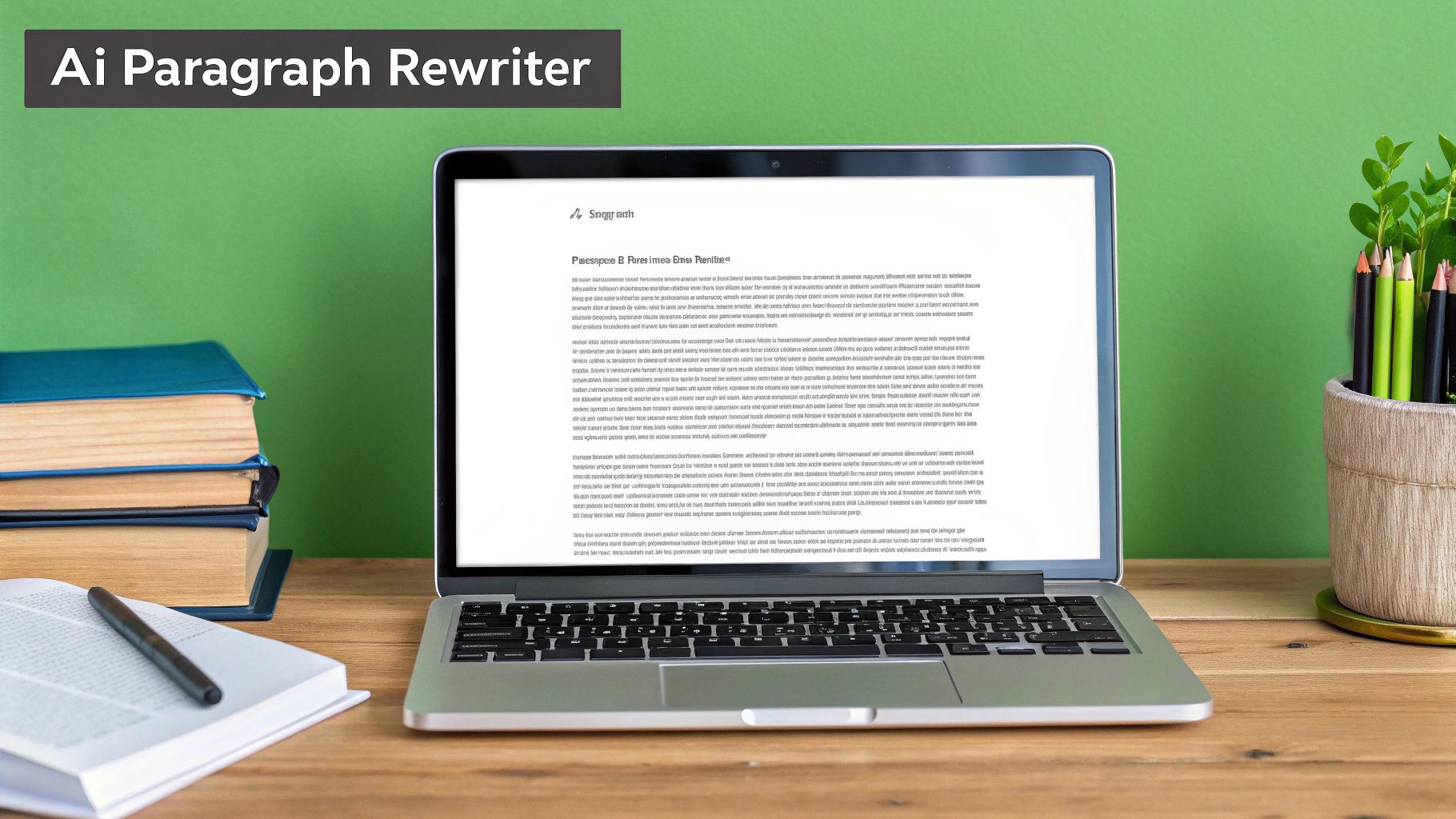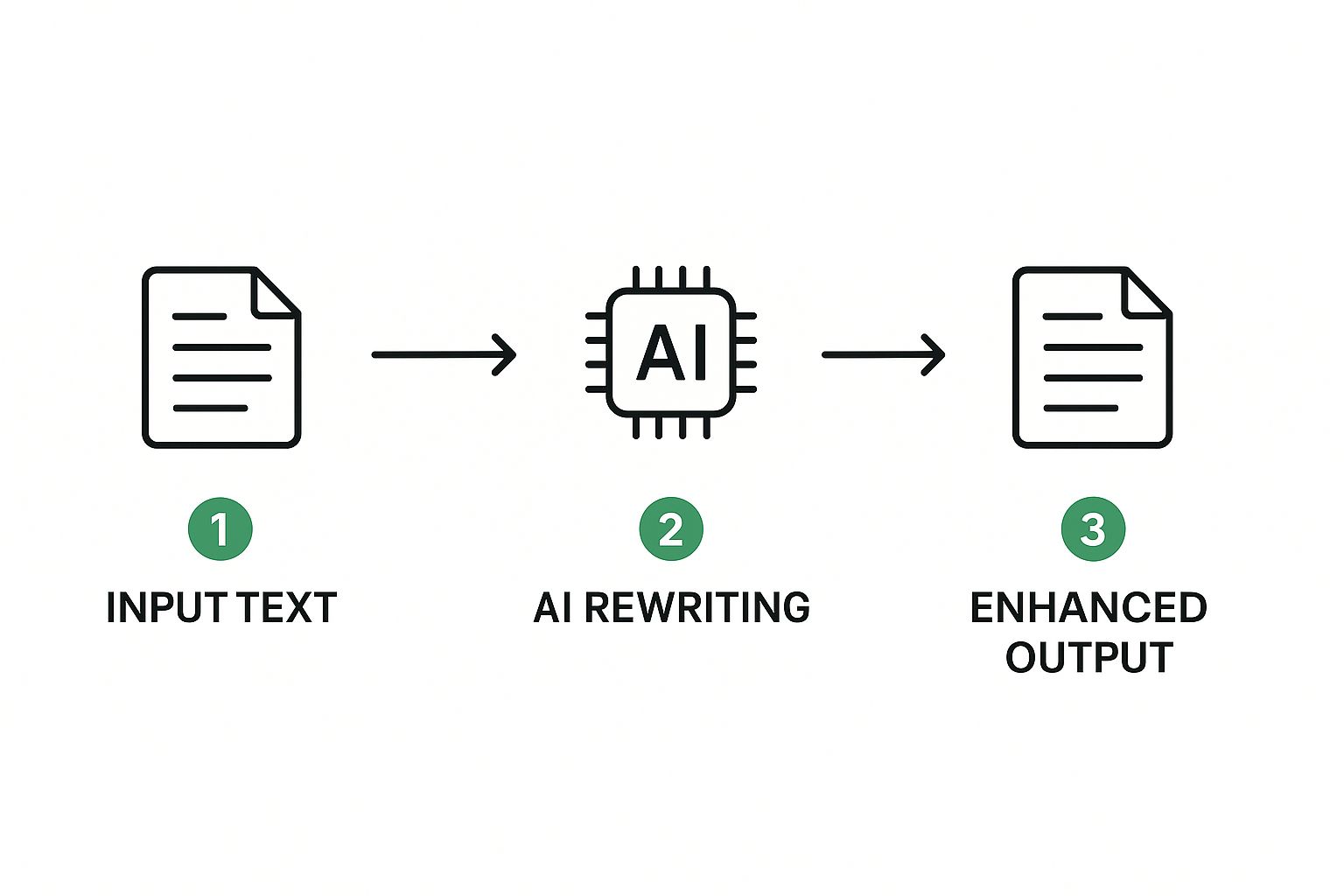
Master the AI Paragraph Rewriter
October 4, 2025
An AI paragraph rewriter is a tool that uses artificial intelligence to rephrase sentences and paragraphs. But let's be clear: this goes way beyond simple synonym swapping. These tools dig into the context, tone, and structure of your original text to generate versions that are clearer, more engaging, or just stylistically different—all while keeping your core message intact.
What an AI Paragraph Rewriter Really Does
So, what’s happening under the hood? An AI paragraph rewriter isn’t just a fancy digital thesaurus; think of it more like a sophisticated writing partner. It's all powered by natural language processing (NLP), which is the technology that allows the software to "understand" language a lot like we do, picking up on the subtle nuances in sentence structure and meaning.
This diagram gives you a peek into how NLP breaks down language into structured data that an AI can actually work with.

The main thing to remember is that the AI isn't just mindlessly swapping words. It’s analyzing the relationships between them to intelligently rebuild your sentences from the ground up.
It’s More Than Just Swapping Words
Instead of just replacing "important" with "significant," a good AI rewriter can completely restructure an idea. For example, it can take a dense, academic sentence and simplify it for a broader audience. Or it can transform a flat, boring statement into persuasive marketing copy. The real goal is to give you fresh ways to express your thoughts, helping you bust through writer's block and find that perfect phrasing.
This technology is moving fast, largely because the market is so competitive. Giants like OpenAI, which holds a 28% market share, followed by Anthropic at 17% and Microsoft at 14%, are constantly pushing the limits of what these tools can do.
A Few Practical Ways to Use It
So how does this actually help you in your day-to-day workflow? An AI paragraph rewriter can slide right in and immediately make a difference.
- Boost Clarity: It’s great at untangling complex sentences and cutting out the jargon.
- Switch Up the Tone: Need to go from formal to casual? Or from neutral to confident? You can do it with a click.
- Generate Quick Variations: This is a lifesaver for marketers who need multiple versions of ad copy or social media posts for A/B testing.
- Smooth Out the Flow: The tool helps connect your ideas more naturally, making sure your paragraphs are cohesive and easy to follow.
Here's a common misconception: people think these tools write for you. The reality? They work best as a collaborator. They're there to help you refine and polish your own ideas, giving you a fresh perspective on your writing.
To give you a clearer picture, here’s a quick breakdown of what these rewriters are designed to do.
Key Rewriter Functions at a Glance
| Function | Primary Goal | Best For |
|---|---|---|
| Tone Adjustment | Modify the emotional style of the text (e.g., formal, friendly) | Aligning content with brand voice or audience expectations. |
| Clarity Enhancement | Simplify complex sentences and remove ambiguity. | Technical writing, academic papers, and instructions. |
| Fluency Improvement | Refine sentence structure for better readability and flow. | Polishing rough drafts and ensuring smooth transitions. |
| Creative Paraphrasing | Generate unique versions of the same idea. | SEO content, social media posts, and avoiding repetition. |
Ultimately, these functions are all about giving you more control over your final text, without having to rewrite everything from scratch.
If you want to see what else is out there, check out these other top AI tools for content creation. And for a deeper dive into the mechanics, you might like our guide on how to use AI to rewrite text effectively.
Finding the Perfect Tone for Your Audience
This is where an AI paragraph rewriter really starts to feel like magic. It’s not just about swapping out a few words; it’s about fundamentally changing how your message lands with your reader. You’re moving beyond a simple "formal" or "casual" choice and strategically shaping your content to connect.
Imagine you're a software developer writing an update. You need to explain a recent change to both your technical team and your non-technical marketing colleagues. The original paragraph is loaded with programming jargon that, while totally accurate, will fly right over the marketing team's heads.

This is the perfect use case for an AI rewriter. You can take that dense, technical text and ask the tool to rewrite it in a "simple" or "engaging" tone. The AI will translate the core concepts into accessible language, focusing on the "what" and "why" instead of the complex "how."
From Jargon to Clarity: A Real-World Example
Let's see this in action.
Original (Technical):
“The recent front-end refactor involved migrating our legacy jQuery dependencies to a modular Vue.js component architecture, which has significantly reduced the initial DOM load time by optimizing our asset bundling process.”
Another developer would get this immediately. But for a marketer? It's just noise.
Rewritten (Simple & Engaging Tone):
“We just finished a major upgrade to our website's code. This change makes pages load much faster for visitors and allows our team to build new features more efficiently.”
See how the core message is still there, but the delivery is completely different? The rewritten version zeroes in on the benefits—faster load times and quicker development—which is what the marketing team actually needs to know. That simple tweak makes sure everyone understands the value of the update.
A common mistake is thinking "professional" and "confident" tones are the same thing. They're not. A professional tone is often neutral and objective. A confident tone is more assertive and persuasive. Picking the right one all comes down to whether you're trying to inform or convince.
Matching Tone to Your Goal
The tone you choose directly guides how your reader feels and what they do next. Getting a handle on the nuances between different tonal options is the key to getting the results you want. For a deeper dive, check out our guide on what is tone in writing and why it's such a big deal.
Think about these common scenarios where an AI rewriter can help:
- Persuasive: Perfect for turning a dry list of product features into benefit-driven marketing copy that actually speaks to customer pain points.
- Empathetic: Incredibly useful for rewriting stock customer support replies to sound more understanding and human.
- Formal: Essential for things like academic papers or business proposals where precision and objectivity are non-negotiable.
When you start playing around with these settings, you learn to use the rewriter as more than just an editor. It becomes a strategic communication tool.
A Practical Guide to Rewriting Your First Paragraph
Jumping into an ai paragraph rewriter is easy, but getting great results every time takes more than just copy-pasting your text and hitting a button. The best writers treat these tools less like a magic wand and more like a smart assistant. It all starts with the quality of your input—what you give the AI directly shapes what you get back.
Before you even open the rewriter, take a moment to clean up your original paragraph. If the text is clunky, confusing, or full of errors, the AI is likely to get tripped up and miss your core message. Think of it as giving the tool a solid foundation to build on.
This simple infographic breaks down the core rewriting process.

As you can see, the AI is just the middle step. The real magic happens when a human comes in to refine and polish the final output.
Generating and Evaluating Your Options
Once your text is ready, paste it into the rewriter. Here’s a pro tip: never settle for the first version it spits out. The best tools will offer multiple alternatives or let you generate new variations with a single click.
I always generate at least three to five different options. This gives me a nice range of styles and phrasing to play with. This is where your writer's intuition kicks in.
As you scan the suggestions, run them through a quick mental checklist:
- Is the original meaning still there? The whole point is to rephrase, not to accidentally change your facts or your argument.
- Does it match the tone I’m going for? If you asked for a "professional" tone, does it sound genuinely authoritative, or just stiff and robotic?
- Does it flow naturally? Read each version out loud. Seriously. It’s the fastest way to spot awkward phrasing that looks fine on the screen but sounds weird when spoken.
The most effective approach is often a hybrid one. Don't feel like you have to accept an AI-generated paragraph wholesale. The best results frequently come from cherry-picking the strongest sentences from different variations and combining them with your own manual tweaks.
Adding the Crucial Human Touch
This final step is non-negotiable if you want to produce high-quality content. Once you’ve picked the best AI-generated base, it’s your turn to make it shine. This is where you inject your unique voice, add a personal story, or swap out a few words to better align with your brand.
For instance, an AI might replace a common industry term with a generic synonym, completely losing the nuance. Your job is to catch those subtle mistakes. This human oversight ensures the final paragraph isn’t just grammatically correct—it's also contextually accurate, authentic, and genuinely sounds like you.
Advanced Techniques for Professional Results
Once you're comfortable with the basics, you can start pushing your AI paragraph rewriter to handle more sophisticated jobs. This is where you move beyond simple tone shifts and start producing genuinely professional content. One of the most effective strategies I've come across is something I call "chain rewriting."
Here’s how it works. Let's say you have a dense, complicated paragraph. Instead of just telling the AI to make it "formal," you first rewrite it for simplicity. Your only goal in this first pass is to break the core ideas into short, easy-to-digest sentences.
Then, you take that clean, simplified output and feed it back into the rewriter. This time, you can apply a "professional" or "confident" tone. Because the AI is starting from a clear and simple base, the final result feels far more polished and natural than if you'd tried to do it all in one shot.
Seamlessly Integrating SEO Keywords
Another pro-level move is using an AI rewriter to weave SEO keywords into your content without it sounding forced or robotic.
Start with your final, well-written paragraph, then pinpoint the keyword you need to add. Instead of just dropping it in and hoping for the best, ask the tool to rewrite a specific sentence to include the term naturally.
For example, if your keyword is "content marketing strategy," you could highlight a sentence and prompt the AI with something like: "Rewrite this to include 'content marketing strategy' while keeping a conversational tone."
This approach lets the AI handle the heavy lifting of restructuring the sentence, ensuring the keyword fits right into the existing flow. If you want to dive deeper into refining text, it's worth exploring some classic paraphrasing techniques that work incredibly well alongside AI tools.
Pro Tip: Never force a keyword where it doesn’t feel right. If a rewritten sentence sounds clunky, just generate a few more variations or try fitting the keyword into a different spot. Your first priority should always be readability for your human audience.
The adoption of these tools is already massive and growing fast. China is leading the charge with a 67% adoption rate, where an incredible 78% of tech companies use AI to create content for social media and e-commerce. India is right there with them at 61%, with 73% of its software firms using AI for multilingual content. You can check out more stats on global AI writing trends on AllAboutAI.com.
Common Mistakes to Avoid With AI Rewriters
Using an AI paragraph rewriter effectively often comes down to knowing what not to do. The biggest trap is treating the tool like a magic button—blindly accepting the first suggestion it gives you without a second thought.
That’s the fastest way to churn out flat, generic content that sounds like it was written by a committee of robots.
Another common pitfall is skipping the final human review. AI-generated text can be sneaky, introducing subtle inaccuracies or awkward phrases that only your eye will catch. Think of the rewritten paragraph as a strong first draft, not the finished product.

Losing Your Unique Voice
This is probably the most damaging mistake of all: letting the AI scrub your personality from the page. If you just accept every suggestion, your distinct writing style gets watered down until it disappears completely.
The goal here is to enhance your writing, not replace you.
Always ask yourself: "Does this still sound like me?" If the answer is no, it's time to jump in and tweak the output manually. Your unique perspective is your greatest asset. Don't let a tool talk over it.
Forgetting to Fact-Check
Finally, never, ever skip the fact-check. This is especially true when you’re rewriting anything technical or data-heavy.
An AI might rephrase a statistic or a key fact in a way that accidentally twists its meaning. It doesn't know the context; it just knows words. Verifying every detail is non-negotiable if you want to maintain credibility and accuracy.
Common Questions About AI Rewriters
AI writing tools are incredibly useful, but it's natural to have questions. Is it plagiarism? Does it actually help with SEO? And how do you stop the output from sounding like a robot wrote it? Let's clear a few things up.
Is Using an AI Paragraph Rewriter Considered Plagiarism?
This is a big one. Using an AI paragraph rewriter isn't automatically plagiarism, but it all comes down to how you use it.
If you copy someone else's article, run it through a rewriter, and publish it as your own, that's definitely crossing the line. But that’s not what these tools are for. Think of it as a smart thesaurus or a brainstorming partner. When you use it to rephrase your own thoughts, simplify a clunky sentence you wrote, or just find a better way to say something, it’s a perfectly fine writing assistant.
The golden rule is simple: make sure the final text reflects your own ideas and always give credit if you're referencing someone else's work.
Will an AI Paragraph Rewriter Help My SEO?
It can, but it’s not a silver bullet for getting to the top of Google. The biggest SEO advantage is that it helps you create unique content variations. This is great for avoiding duplicate content penalties when you're repurposing a blog post for social media or an email newsletter.
A rewriter can also help you weave keywords into your text more naturally so it doesn't sound stuffed or awkward.
But at the end of the day, good SEO is about good content. Your writing still needs to be high-quality, relevant, and genuinely helpful to your reader. Use the tool to make your writing better, not just to spin it for search engines.
How Can I Make Rewritten Text Sound More Natural?
The secret ingredient is you. Never just copy, paste, and publish what an AI gives you. A human review is essential.
My go-to trick? Read the rewritten text out loud. You'll immediately catch any weird phrasing or sentences that just don't flow right.
Don't be afraid to get your hands dirty. Manually tweak a few words, combine ideas from different AI suggestions, and inject a bit of your own personality. The best results always come from a partnership—your creativity and the AI's efficiency working together.
Ready to turn your AI drafts into polished, human-sounding content? Natural Write instantly refines your text to fly past AI detectors and read like you wrote it yourself. Try Natural Write for free and feel the difference.


